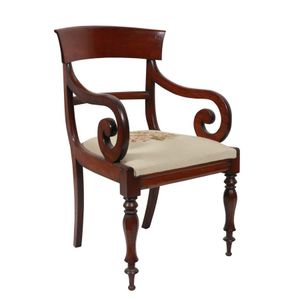Curved Cedar Chair with Turned Legs
You must be a subscriber, and be logged in to view price and dealer details.
Subscribe Now to view actual auction price for this item
When you subscribe, you have the option of setting the currency in which to display prices to $Au, $US, $NZ or Stg.
- Turning - Any part of a piece of furniture that has been turned and shaped with chisels on a lathe. Turned sections include legs, columns, feet, finials, pedestals, stretchers, spindles etc. There have been many varieties and fashions over the centuries: baluster, melon, barley-sugar, bobbin, cotton-reel, rope-twist, and so on. Split turning implies a turned section that has been cut in half lengthwise and applied to a cabinet front as a false decorative support.
- Turned Legs - are legs which have been turned on a lathe. In use from the 16th century, turned legs on tables, chairs and cabinets became more frequent until, by the 1830s, the Georgian square or tapered leg was rarely found except in country pieces.
- Splat - The central back support between the top rail and the seat in chairs and couches. They may take a variety of forms, and run either horizontally or vertically.
- Drop in Seat - Mostly used on Regency upright chairs, a drop in (or "drop on") seat is an unsprung removable seat where the upholstery is attached to a wooden frame, which is held in place by the sides of the chair, and usually a wooden peg at the front of the chair. An inset upholstered seat is of the same construction, but it sits within a frame whose perimeter includes four sides of the chair.
Because the upholstery frame was not very deep, the seats were relatively uncomfortable. In the mid 19th century coiled upholstery springs came into use and frame of the chair was used as the upholstery frame, making for a much more comfortable and responsive seat.
This type of seat was known as an over-upholstered or over-stuffed seat.
This item has been included into following indexes:
Visually similar items

Victorian armchair cedar spade back, tapestry upholstery, & octagonal tulip legs

Two Regency mahogany carvers, early 19th century, each with curved panelled top rail above a carved cross-rail, over scrolled arms, green leatherette seat, on turned and reeded legs (2), height 87 cm

Pair of English Gothic revival oak armchairs, 1875, carved trefoil design with leather seats (2), height 92 cm. Provenance: The Estate of Julie Biber

George IV mahogany carver, early 19th century, the overhanging top rail above a carved cross-rail, over scrolled arms, drop-in seat upholstered in a striped fabric, raised on sabre legs, retains British antique Dealer Association label, restored, height 87
